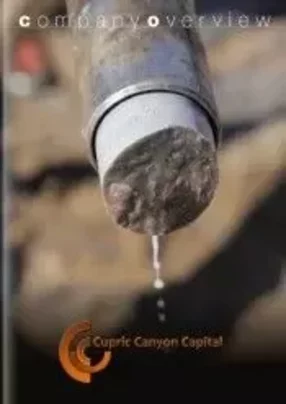The Khoemacau Project is in full swing having been rigorously planned over the past five years, and is now gearing up for the construction phase in line with its goal of beginning production in 2017.
Formed under the global Cupric Canyon Capital company following the acquisition of Hana Ghanzi Copper Ltd in early 2013, Khomecau has subsequently built upon the work already being carried out in the region knowing that the expertise available within the Cupric Canyon organisation would be a perfect match for the project.
After a review of more than 250 projects throughout the world, the Khoemacau Project was chosen based on very selective criteria, as Chief Executive Officer, Sam Rasmussen explained: “We’re a private company, and our goal is to create value for all of our stakeholders while maintaining the highest industry standards for safety and the environment.
“The benefits of developing an operation such as this in Botswana included the quality of the project, the ease of operating here, the attractive labour force, the transparency and lack of corruption in the country and the investor-friendly mining code and legislation that exists here.
“We identified what Hana had done up to that point and we were very impressed with the results. Although the M&I (measured and indicated) reserves were low at the time, we had a very strong sense for the project’s upside potential which has since been confirmed.”
Planning ahead
Hana’s drilling campaign hit a scale of 30,000 metres, a figure which the Khoemacau Project has quickly and effectively surpassed having reached numbers between 150,000 and 200,000 metres in just a 24 month period to bring it up to a satisfactory M&I reserve level.
This means that Rasmussen and his team can turn their attention towards the next stage of the project; namely preparing for construction with a view to production in 2017.
“We are just finishing the feasibility study and are now transitioning to the FEED (front end engineering design) stage,” the CEO said. “Cupric is strongly committed to the project and we are prepared to begin construction once we have received government approval.”
This planning forms arguably the most integral stage of the entire project, with the infrastructure and logistical challenges all addressed, building up to the commencement of production.
“In the next three months there are some construction activities that will commence related to the development of water supply, temporary power generation and the camp,” Rasmussen continued. “Once this is completed, we can focus our attention on underground mine development and surface facilities.”
There is now a fully functioning camp to cater for the 300 employees already working on this initial infrastructure, and the challenge now is to take the next step towards the larger structure, incorporating equipment, drainage, traffic considerations, power supply and water volume requirements.
Competitive product
Building toward the company’s 2017 goal, Khoemacau recently submitted an application for a mining licence and expects to receive approval before the end of 2014. This would confirm the rewards of an investment that has totalled around $160 million up to this point, including the cost of acquiring Hana Mining Ltd., Khoemacau’s parent company.
Now officially a medium sized mining project, the Company can partially turn its attention toward the end product and marketing-related matters.
“The final product from the mine is a copper-silver concentrate, the content of which is 40 percent copper and 347 g/t silver,” Rasmussen explained. “Our payable product will be 50,000 tonnes per annum of copper, contained in 125,000 tonnes of copper-silver concentrate from the operation.”
Not only is Rasmussen excited about the volume of production, but also the cleanliness of the concentrate which will surpass many competitors in terms of quality, which means that more than one buyer is already at the door, years in advance.
Local responsibilities
Running parallel with the ongoing focus on future economic success and continuous improvement has always been the Khomecau Project’s commitment to the region in which it operates, a dedication that was earmarked from the beginning simply in naming the subsidiary.
“’Khoemacau’ is a combination of five words from the sandman tribes that live on the central Kalahari Game Reserve here, meaning ‘hills of the people’, and it was chosen by a local school after we got the local communities involved to help us name our project,” Rasmussen said. “Assisting the nearby communities and people is very important when mining companies operate in small communities, so we’ve made a point of carrying out socially responsible activities like building schools, wells, houses and even clinics.”
This local emphasis translates to its own employment strategies too, with more than 90 percent of the current workforce of 300 coming from Botswana.
Despite a shortage of skills in some areas, Khoemacau is certainly not taking an ‘out of sight, out of mind’ approach and is instead devoting itself to the training and development of indigenous, willing workers to build for the future of the mine in the hope that operations will be managed almost exclusively by Batswana in the years ahead.
“It’s the philosophy of the company; if we don’t have the expertise we develop it, if we don’t have something we build it,” Rasmussen concluded. “It may take five or 10 years but you’ve got to think long term, and our development plan for the project is consistent with this philosophy.
“In five years’ time I’m positive I’ll be able to report back that Khoemacau successfully started up in 2017 and continues to exceed production expectations, all while operating smoothly and safely and empowering the people of Botswana.”
- Top 10: Mineral Producing Countries in AfricaSupply Chain & Operations
- Galiano awards mining contract for Asanko Gold Mine in GhanaSupply Chain & Operations
- Caledonia Mining Corporation expands Zimbabwe portfolioSupply Chain & Operations
- CNMC's Project Deziwa realises China's 'Go Global' strategySupply Chain & Operations


